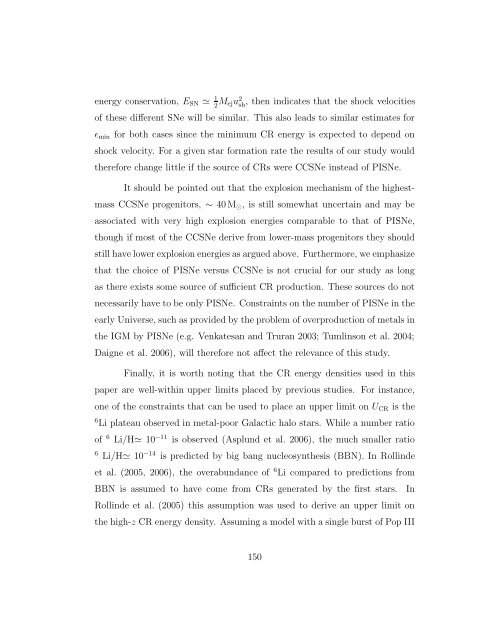Copyright by Athena Ranice Stacy 2011 - The University of Texas at ...
Copyright by Athena Ranice Stacy 2011 - The University of Texas at ...
Copyright by Athena Ranice Stacy 2011 - The University of Texas at ...
Create successful ePaper yourself
Turn your PDF publications into a flip-book with our unique Google optimized e-Paper software.
energy conserv<strong>at</strong>ion, ESN 1<br />
2Meju2 sh , then indic<strong>at</strong>es th<strong>at</strong> the shock velocities<br />
<strong>of</strong> these different SNe will be similar. This also leads to similar estim<strong>at</strong>es for<br />
ɛmin for both cases since the minimum CR energy is expected to depend on<br />
shock velocity. For a given star form<strong>at</strong>ion r<strong>at</strong>e the results <strong>of</strong> our study would<br />
therefore change little if the source <strong>of</strong> CRs were CCSNe instead <strong>of</strong> PISNe.<br />
It should be pointed out th<strong>at</strong> the explosion mechanism <strong>of</strong> the highest-<br />
mass CCSNe progenitors, ∼ 40 M⊙, is still somewh<strong>at</strong> uncertain and may be<br />
associ<strong>at</strong>ed with very high explosion energies comparable to th<strong>at</strong> <strong>of</strong> PISNe,<br />
though if most <strong>of</strong> the CCSNe derive from lower-mass progenitors they should<br />
still have lower explosion energies as argued above. Furthermore, we emphasize<br />
th<strong>at</strong> the choice <strong>of</strong> PISNe versus CCSNe is not crucial for our study as long<br />
as there exists some source <strong>of</strong> sufficient CR production. <strong>The</strong>se sources do not<br />
necessarily have to be only PISNe. Constraints on the number <strong>of</strong> PISNe in the<br />
early Universe, such as provided <strong>by</strong> the problem <strong>of</strong> overproduction <strong>of</strong> metals in<br />
the IGM <strong>by</strong> PISNe (e.g. Venk<strong>at</strong>esan and Truran 2003; Tumlinson et al. 2004;<br />
Daigne et al. 2006), will therefore not affect the relevance <strong>of</strong> this study.<br />
Finally, it is worth noting th<strong>at</strong> the CR energy densities used in this<br />
paper are well-within upper limits placed <strong>by</strong> previous studies. For instance,<br />
one <strong>of</strong> the constraints th<strong>at</strong> can be used to place an upper limit on UCR is the<br />
6 Li pl<strong>at</strong>eau observed in metal-poor Galactic halo stars. While a number r<strong>at</strong>io<br />
<strong>of</strong> 6 Li/H 10 −11 is observed (Asplund et al. 2006), the much smaller r<strong>at</strong>io<br />
6 Li/H 10 −14 is predicted <strong>by</strong> big bang nucleosynthesis (BBN). In Rollinde<br />
et al. (2005, 2006), the overabundance <strong>of</strong> 6 Li compared to predictions from<br />
BBN is assumed to have come from CRs gener<strong>at</strong>ed <strong>by</strong> the first stars. In<br />
Rollinde et al. (2005) this assumption was used to derive an upper limit on<br />
the high-z CR energy density. Assuming a model with a single burst <strong>of</strong> Pop III<br />
150









